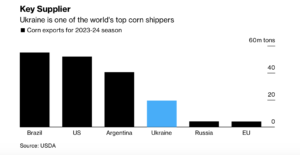Bloomberg's Clarice Couto reported this past Friday that "a surprising tax change in agriculture powerhouse Brazil has the potential to make soy grown in the world’s largest bean exporter less…
Ukraine Takes “Bold Steps” to Export Its Grain, as Better Than Expected Harvest Unfolds
Bloomberg writer Olesia Safronova reported today that, “As Ukraine’s farmers labor through their second wartime harvest, they’re expecting a big one. They just don’t know how much of it will ever make it to market.
“Russian attacks on export routes through both the Black Sea and Danube River remain a constant threat for shipping out crops that help feed the world. That’s making it harder and more expensive to squeeze cargoes out through Europe, causing supplies to pile up in Ukraine.
“On top of that, many farmers are having to export crops themselves after major trading companies pulled back from the country following Moscow’s invasion.”

“While the overall harvest is still about a quarter smaller than before the war, it’s coming in better than expected and bigger than last year,” the Bloomberg article said.
Safronova added that, “But getting those crops out to the world is proving difficult, even with Kyiv this week sending a small grain shipment through the Black Sea for the first time in months as it tries to defy Moscow’s blockade of critical waterway. And it’s too early to know if that corridor will lead to big shipments.
“For now, much of its exports are leaving via the Danube, as well as rail and truck routes into the European Union. The lengthy alternatives are a contentious issue that has seen some EU nations impose their own bans on imports from Ukraine as the bloc ended restrictions.”
More broadly on Black Sea transportation, Matthew Mpoke Bigg reported in today’s New York Times that,
Ukraine took two bold steps toward securing export routes for its vital grain industry on Tuesday, sending a ship loaded with wheat along a new Black Sea route in the face of Russian naval aggression and challenging one of its main allies, Poland, over its opposition to Ukrainian imports.
Bigg explained that, “The importance of establishing a new sea route grew still greater this week in the face of a renewed dispute between Ukraine and its grain-producing European Union neighbors about overland exports.
“But though the Resilient Africa appears to have navigated itself safely out of Ukrainian waters, experts say much uncertainty remains over whether the country will be able to rebuild a vital industry weighed down by 19 months of war.”
The Times article pointed out that, “Amid attacks on military targets by both sides across large expanses of water, the success of Ukraine’s new export route may hinge on the willingness of commercial shipping companies to risk their vessels, according to Sal Gilbertie, the chief executive of Teucrium, a U.S.-based investment advisory firm.
“‘The corridor is a good idea, but I think it is a test of what the Russians will allow’ in the Black Sea, he said.”
At the high-level meeting on Call for #FoodSecurity organized by 🇫🇷 @MinColonna during #UNGA78, I presented the intensive efforts of 🇷🇴 in support of 🌎food security, facilitating the transit of over 2️⃣5️⃣.5️⃣mln tons of 🇺🇦 grain to world markets. Reassured on our support for UA. pic.twitter.com/8ShUEtOwZd
— Luminita Odobescu (@Odobes1Luminita) September 20, 2023
And Wall Street Journal writer Yaroslav Trofimov reported today that, “Commercial vessels have resumed using Ukraine’s main port of Odesa without asking permission from Russia for the first time since the war began—showing just how much the balance of power has changed in the Black Sea.
“By imposing an asymmetrical war that relies on domestically produced naval drones and missiles, and that targets Russians ships in their own home bases, Ukraine has eroded much of Russia’s vaunted naval superiority. Now, it is taking the battle to Russia itself.
“‘To ensure our security, now and in the future, we must start the defense of our shore on the shore of the enemy,’ the commander of the Ukrainian navy, Vice Adm. Oleksiy Neizhpapa, said in an interview. ‘This is an approach that we’re trying to implement little by little.'”
The Journal article pointed out that, “With the grain deal dead, Ukraine’s military last month announced a unilateral corridor for civilian maritime traffic to and from Odesa. Six vessels have already left Odesa’s ports through that corridor in recent days, including one of the two bulk carriers under the flag of Palau that arrived here to load up with grain last Saturday.
“Ukraine’s new ability to hit Russian ports has made this development possible, officials say.”
Trofimov noted that, “In addition to Odesa, Ukraine has also developed trade through its seaports on the Danube Delta, on the border with Romania. In recent months, the three Danube ports—Izmail, Reni and Kiliya—have been repeatedly hit by swarms of Iranian-made Shahed drones, which according to Ukrainian officials have destroyed stores with some 270,000 tons of grain, alongside trucks and port infrastructure. Some of these drones fell on the Romanian shore of the river.
“Still, Ukraine’s Danube ports continue operating at near-full capacity.”
“In August, the Danube ports handled 3.2 million tons of cargo, said [Dmytro Barinov, deputy chief executive of the Ukrainian Sea Ports Authority], with 2.5 million of them food exports. By comparison, the ports of Odesa were exporting as much as 4.2 million tons of food a month under the grain deal.”







